|
|
 |
 |
 |
 |
|
Garmin
eTrex Summit GPS receiver Review |
28th September 2003 |
|
|
 Reviewed
by
Dave Burrows Reviewed
by
Dave Burrows
What
do you get?
The
Garmin eTrex Summit receiver is priced at around £170 including
VAT
and comes complete with an eTrex
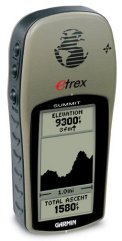 Summit Hiking Companion, a wrist
strap, a user guide, and of course the Summit Receiver itself.
The summit due to it's pricing doesn't come with a PC data cable, so
if you want to hook the eTrex Summit up to your PC, you will need to
purchase this separately. Garmin currently sell the PC data
cable for around £25 or £45 for a USB to Serial cable, so you have to
think about factoring this into the cost of the receiver, hence why
it's cheaper than other receivers like the eTrex Vista we previously
reviewed. Another thing the Summit comes without is batteries.
Not a major problem, but you do get batteries free with the more
expensive Garmin's. I think this is something Garmin could have
included for what batteries really cost. Summit Hiking Companion, a wrist
strap, a user guide, and of course the Summit Receiver itself.
The summit due to it's pricing doesn't come with a PC data cable, so
if you want to hook the eTrex Summit up to your PC, you will need to
purchase this separately. Garmin currently sell the PC data
cable for around £25 or £45 for a USB to Serial cable, so you have to
think about factoring this into the cost of the receiver, hence why
it's cheaper than other receivers like the eTrex Vista we previously
reviewed. Another thing the Summit comes without is batteries.
Not a major problem, but you do get batteries free with the more
expensive Garmin's. I think this is something Garmin could have
included for what batteries really cost.
The eTrex Summit as it's primarily for Hiking doesn't come with a base
map of any sort, so again this is something you need to factor in if
you're looking for maps. The eTrex Summit is great from a hiking
point of view, because you can create tracks and use the track back
facility. The Summit comes with no memory for map data, so you cannot load any Garmin
MapSource maps onto it. If you're looking for a
handheld GPS with a map, then you will really need to look at the
eTrex Vista or GPSMap76 which comes with 24mb of RAM.
Garmin's MapSource comes in various flavours, the one we have tested
previously was the Europe MetroGuide which comes on a double CD and
provides management software and map data for the Garmin courtesy of
NavTech Maps.

The
cable set used connecting the Summit to the Pocket PC was provided by
PC-Mobile
and comes in a number of modular
pluggable
cables which can be set into a number of configurations or you can
by a new adapter for another Pocket PC without having to by a complete
lead set.
|
|
Garmin
eTrex Summit Specification
The
manufacturer's specification are quoted here.
Navigation
Features
-
Waypoints/Icons: 500 with name and graphic symbol
- Tracks:
Automatic track log; 10 saved tracks let you retrace your path in both
directions
- Routes:
20 reversible routes with up to 50 waypoints
- Trip
computer: Current speed, average speed, time of
sunrise/sunset, resetable maximum speed, trip timer, and trip distance
- Map datums:
More than 100
- Position
format: Lat/Lon, UTM/UPS, Maidenhead, MGRS, Loran TDs, and
other grids
Electronic compass features
-
Accuracy: ±2 degrees with
proper calibration (typical); ±5 degrees in extreme northern and
southern latitudes
-
Resolution: 1 degree
Barometric altimeter features
-
Accuracy: 10 feet with proper
calibration (user and/or automatic calibration)
-
Resolution: 1 foot
-
Range: -2,000 to 30,000 feet
-
Elevation
computer: Current elevation, resetable minimum and maximum
elevation, ascent/descent rate, total ascent/descent, average and
maximum ascent/descent rate
-
Pressure: Local pressure
(mbar/inches HG), 12-hour automatic pressure trend recording
GPS Performance
-
Receiver: WAAS not supported, 12 parallel channel GPS receiver continuously
tracks and uses up to 12 satellites to compute and update your
position
Acquisition Times:
- Warm: approx. 15 seconds
- Cold: approx. 45 seconds
- AutoLocate™: approx. 5 minutes
- Update Rate: 1 second, continuous
GPS Accuracy:
- Position: 15 meters (49 feet) RMS
- Velocity: 0.1 knot RMS steady state
Dynamics: 6g's
Interfaces: RS232 with NMEA 0183, RTCM 104 DGPS data format and
proprietary GARMIN
Antenna: Built-in patch
Physical
- Size:
4.4"H x 2.0"W x 1.2"D (11.2 x 5.1 x 3.0 cm)
- Weight: 5.3 ounces (150 g) with batteries
- Display: 2.1"H x 1.1"W (5.4 x 2.7 cm) high-contrast LCD with
bright backlighting
- Case: Waterproof to IEC 529 IPX7 standards
- Temperature range: 5°F to 158°F (-15°C to 70°C)
- Data storage: Indefinite; no memory battery required
- Internal Memory: None
Power
- Source: 2 AA batteries (not included)
- Battery Life: Up to 16 hours (typical use) |
|
The Garmin
eTrex Summit Receiver
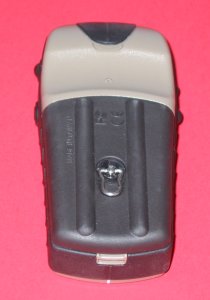  The
first thing you notice when you take the Summit out of the box is
just how tiny it really is. It's about the size of a regular
Nokia mobile phone in height and it's very light weight! The
battery compartment is situated on the back and comprises of 2xAA
batteries (not supplied). Although you could put rechargeable NiCad or NiMh
batteries in there, the Summit tends to prefer alkaline, and bear in
mind that rechargeable batteries supply 2.4 volts as opposed to 3
volts. The
first thing you notice when you take the Summit out of the box is
just how tiny it really is. It's about the size of a regular
Nokia mobile phone in height and it's very light weight! The
battery compartment is situated on the back and comprises of 2xAA
batteries (not supplied). Although you could put rechargeable NiCad or NiMh
batteries in there, the Summit tends to prefer alkaline, and bear in
mind that rechargeable batteries supply 2.4 volts as opposed to 3
volts.
Like a lot of the Garmin range, the
Summit has a rugged waterproof case and it shows with rubber seals to
keep water out of every nook and cranny.
The Summit sits nicely in the palm of
your hand, and is designed so that you can operate all the buttons
single handed so you can keep your other hand free, and this works
well.
The display is a four level gray LCD screen with backlight. It has a
low resolution
screen of 128 by
64 pixels (not has high as it's big brother the eTrex Vista).
On the back of the receiver there is the quarter turn battery
locking mechanism hiding the two AA sized batteries.
Also on the back located
behind a rubber gasket is the Garmin proprietary interface connector. It is this connector that allows the Garmin to be interfaced to
either a PC or more importantly your PDA.

You'll see from the photo above how small it is. The eTrex
Summit is placed in the middle of a Samsung flip clam shell mobile
phone (left) and a HP iPAQ 2210 (right).
|
|
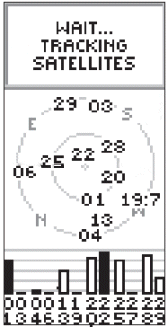 GPS
Satellite Fixing GPS
Satellite Fixing
After
experiencing the strength of the Garmin GPSMap76, and being spoilt
for choice, we were kind of expecting the same excellence in signal
strength. One thing to note is that the antenna's on the
Summit
and GPSMap76 are different, the GPSMap76 sports a quad helix antenna
where as the eTrex range has a patch antenna. This does show, and
performance isn't as great as Garmin's using the quad helix, but
still the performance is more than acceptable compared to most GPS
receivers.
The
Summit in our tests seems to receive more signal when horizontal or
at a 45 degree angle, where as Garmin's with the quad helix tend to
see more signal strength when held vertical, which is corroborated
from views of other GPS users.
The
Satellite screen shows up to 12 satellites it knows are in the sky,
and shows which ones have complete ephemeris data for and which
one's its currently getting this from, to the right you'll see a 4
satellite 3D fix.
The
average fix I seemed to receive was around the 50 second mark,
although I did have some longer fixes of around the 2 minute mark
when it failed to download a complete set of ephemeris data in the
allotted time period.
 One
thing I do like on the Garmin's, is leave them for a few minutes and
they'll bleep at you and come back telling you they couldn't receive
a full fix, would you like to continue ? or initiate a cold/factory fix
?,
which I really do think should be something that should be added
into most Pocket PC GPS Receivers, or at least the applications.
This would help diagnose TTFF problems and help people see there's a
problem quicker rather than dumbly sit there waiting for a fix. One
thing I do like on the Garmin's, is leave them for a few minutes and
they'll bleep at you and come back telling you they couldn't receive
a full fix, would you like to continue ? or initiate a cold/factory fix
?,
which I really do think should be something that should be added
into most Pocket PC GPS Receivers, or at least the applications.
This would help diagnose TTFF problems and help people see there's a
problem quicker rather than dumbly sit there waiting for a fix.
Holding
a fix is just as important as getting the first fix, and the
Summit
was certainly able to do that, however compared to the GPSMap76, we
did notice the signal bar's jumping around quite a bit whilst using
the Summit for in-car use. I think this would have been where
the quad helix antenna would come in better, but adding support for
this inside the Summit would increase it's size substantially.
 Comparing
the Summit to it's big brother the Vista, you do lack some of the
extra applications that the Vista holds like a Calculator and a
Calendar. Comparing
the Summit to it's big brother the Vista, you do lack some of the
extra applications that the Vista holds like a Calculator and a
Calendar.
These aren't really essential applications for a GPS,
but you do see these on more and more mobile phones now a days, so
you can really do without them on a handheld GPS Receiver if you do
carry a mobile phone around with you.
A further welcome edition not seen in many of the
lower spec Garmin's is a compass that not only works as a compass
should, but to be able to tell you what direction to travel towards
for your next waypoint. This is a very neat feature, and is
not tied to GPS signal, so you can quite happily use this if the
Global Positioning System signals were blocked or not available for
whatever reason.
Something
you see on most Garmin's now a days is the barometric altimeter that gives you
the distance and maximum elevation plotted to a graph.
Something that is lacking on the Summit compared to the Vista is you
don't see a Sun and Moon screen which will give you sunrise, sunset,
moonrise and moonset times for your current location. You are
also lacking a Hunt & Fish screen, but I always wonder how effective
this screen usually is. |
|
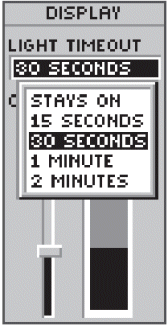 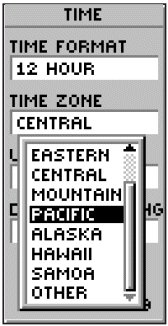 Summit
Setup Menus Summit
Setup Menus
The Summit
doesn't have the new Garmin Click Stick, so you have to navigate the menu's
on the Summit using a page through button, and up and down selectors
with an enter button.
It's good to
see everything is accessible quickly without having to wade through
countless menus.
On the
main setup menu you have everything you need here from setting the
time formats from 12 to 24 hours, the time zone you're currently
located in, any UTC offset and whether you are currently in Daylight
Savings Time.
The date
and time will be set when you acquire your first fix, and on future
fixes as this is synchronised as part of the NMEA sentence received. One thing
that is important on gray scale screens is a contrast control,
depending on whether you're in shade, or in the open bright sun, you
may need to tweak contrast and the Summit
like other Garmin's has a 4 level gray scale control with a backlight facility that you can set to a timeout of 15 seconds
up to 2 minutes in length before the backlight will turn itself off.
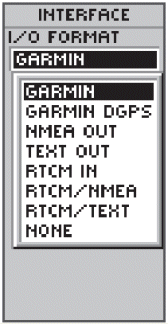 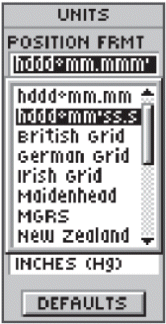
As in
previous Garmin's, Garmin offer a rich serial data format comprising
of Garmin's own proprietary format, Garmin DGPS for Differential or
WAAS data, NMEA In/NMEA Out which is the standard that most people
would use when connecting to a PC or Pocket PC, Text Out, RTCM In,
RTCM In/NMEA Out, RTCM In/Text Out. This gives
users of the Summit a vast amount of export options allowing for both WAAS and NMEA data transfer.
You can also change the units
that are displayed on the Summit in the Position Format and Garmin
offer a large selection of Map Datum Support for nearly all Map
Datum's in existence. WGS 84 is the default selection which
corresponds to World Geodetic Survey 1984 and is the most commonly
used.
As Garmin
have included full magnetic compass support in the Summit, you have a
function to automatically switch off the compass over a particular
speed. This is handy because the Compass does use up a lot
more battery power, and one thing Garmin do stipulate is to not have
the Compass turned on all the time.
|
|
Connecting the Summit to a
Pocket PC
This can be done very easily with a cable set supplied from
PC-Mobile.
All you need to do is set the Garmin Summit interface to NMEA
In/NMEA Out, and connect it up to your Pocket PC and use any GPS
package set to COM1 and NMEA 4800 and you should start receiving
the NMEA data stream.
This can be verified by using
WinFast Navigator which is available on our downloads page, or
G7To CE which is also available from our downloads page.
|
|
Strengths
and Weaknesses
The unit tested is an affordable GPS system. The receiver doesn't support WAAS or loading of Garmin's own map products. If you want
something with a few more features over it's little brother the eTrex,
then the Summit will probably be okay, however if you want to add
support for maps, then you really should look at the eTrex Vista or
GPSMap76. Garmin and others do produce cheaper
units for just over £100 which compare favourably in price
to sleeve and Compact Flash GPS Receivers. Another thing to
bear in mind is that the resolution is lower than that of the eTrex
Vista.

|
|
|
 |
 |
 |
 |
|
|